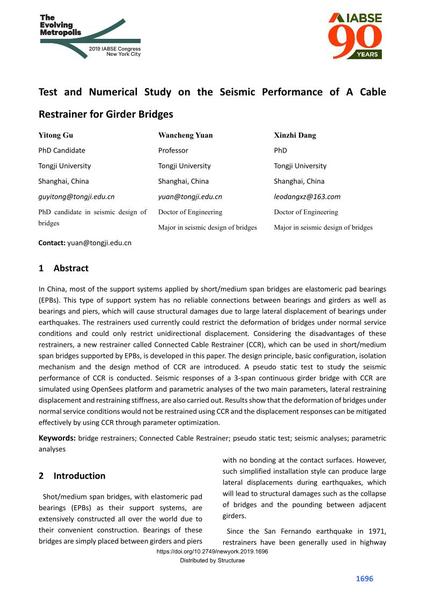Test and Numerical Study on the Seismic Performance of A Cable Restrainer for Girder Bridges

|
|
|||||||||||
Bibliographic Details
| Author(s): |
Yitong Gu
(Tongji University)
Wancheng Yuan (Tongji University) Xinzhi Dang (Tongji University) |
||||
|---|---|---|---|---|---|
| Medium: | conference paper | ||||
| Language(s): | English | ||||
| Conference: | IABSE Congress: The Evolving Metropolis, New York, NY, USA, 4-6 September 2019 | ||||
| Published in: | The Evolving Metropolis | ||||
|
|||||
| Page(s): | 1696-1705 | ||||
| Total no. of pages: | 10 | ||||
| DOI: | 10.2749/newyork.2019.1696 | ||||
| Abstract: |
In China, most of the support systems applied by short/medium span bridges are elastomeric pad bearings (EPBs). This type of support system has no reliable connections between bearings and girders as well as bearings and piers, which will cause structural damages due to large lateral displacement of bearings under earthquakes. The restrainers used currently could restrict the deformation of bridges under normal service conditions and could only restrict unidirectional displacement. Considering the disadvantages of these restrainers, a new restrainer called Connected Cable Restrainer (CCR), which can be used in short/medium span bridges supported by EPBs, is developed in this paper. The design principle, basic configuration, isolation mechanism and the design method of CCR are introduced. A pseudo static test to study the seismic performance of CCR is conducted. Seismic responses of a 3-span continuous girder bridge with CCR are simulated using OpenSees platform and parametric analyses of the two main parameters, lateral restraining displacement and restraining stiffness, are also carried out. Results show that the deformation of bridges under normal service conditions would not be restrained using CCR and the displacement responses can be mitigated effectively by using CCR through parameter optimization. |
||||
| Keywords: |
seismic analyses bridge restrainers Connected Cable Restrainer pseudo static test parametric analyses
|
||||
